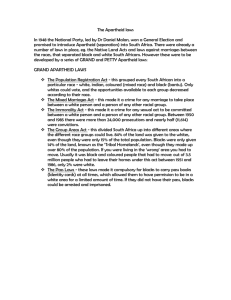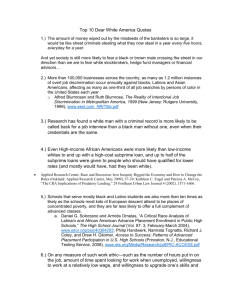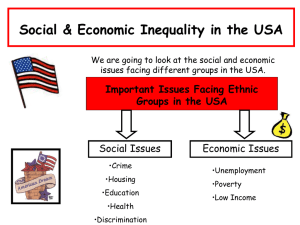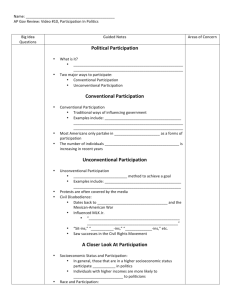RACIAL/ETHNIC DISPARITIES IN TRAFFIC STOPS: Stephanie Seguino
advertisement
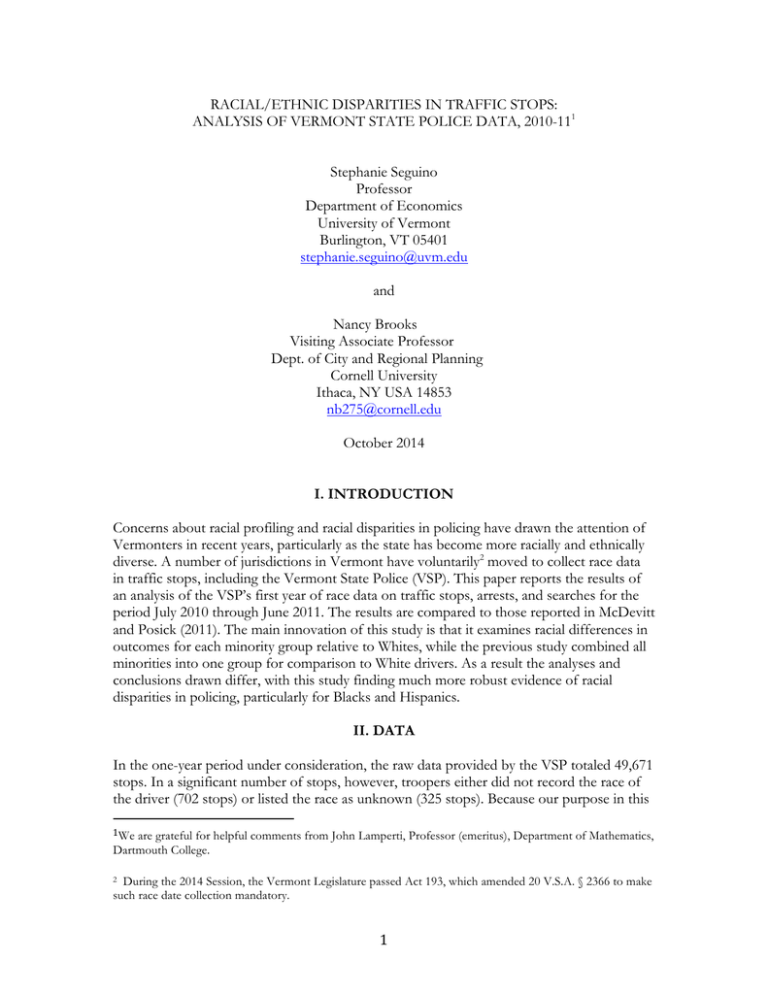
RACIAL/ETHNIC DISPARITIES IN TRAFFIC STOPS: ANALYSIS OF VERMONT STATE POLICE DATA, 2010-111 Stephanie Seguino Professor Department of Economics University of Vermont Burlington, VT 05401 stephanie.seguino@uvm.edu and Nancy Brooks Visiting Associate Professor Dept. of City and Regional Planning Cornell University Ithaca, NY USA 14853 nb275@cornell.edu October 2014 I. INTRODUCTION Concerns about racial profiling and racial disparities in policing have drawn the attention of Vermonters in recent years, particularly as the state has become more racially and ethnically diverse. A number of jurisdictions in Vermont have voluntarily2 moved to collect race data in traffic stops, including the Vermont State Police (VSP). This paper reports the results of an analysis of the VSP’s first year of race data on traffic stops, arrests, and searches for the period July 2010 through June 2011. The results are compared to those reported in McDevitt and Posick (2011). The main innovation of this study is that it examines racial differences in outcomes for each minority group relative to Whites, while the previous study combined all minorities into one group for comparison to White drivers. As a result the analyses and conclusions drawn differ, with this study finding much more robust evidence of racial disparities in policing, particularly for Blacks and Hispanics. II. DATA In the one-year period under consideration, the raw data provided by the VSP totaled 49,671 stops. In a significant number of stops, however, troopers either did not record the race of the driver (702 stops) or listed the race as unknown (325 stops). Because our purpose in this 1We are grateful for helpful comments from John Lamperti, Professor (emeritus), Department of Mathematics, Dartmouth College. During the 2014 Session, the Vermont Legislature passed Act 193, which amended 20 V.S.A. § 2366 to make such race date collection mandatory. 2 1 analysis is to examine racial disparities, as a first step in our analysis, we removed observations where the race of the driver was marked as “unknown” or missing. In all, we dropped 2.1 % of all observations. Since Vermont licenses do not identify the race or ethnicity of the driver, troopers rely on their own perceptions of race to categorize said drivers. In addition to race, data collected include gender of the driver, the time and location of the stop, reason for and outcome of stops, officer name, barracks, and data on searches. III. DATA ANALYSIS A. Stop Rates Table 1 compares traffic stops and stop rates by race/ethnicity. Stop rates are defined as the number of stops for each racial/ethnic group as a percentage of all stops. There are several methods for assessing racial disparities in stop rates. A straightforward method used in most studies is to compare the racial shares of traffic stops with the share of each racial group in the population based on 2010 US Census Bureau data. We use that method here as the best available proxy for the racial make-up of Vermont drivers. With regard to the racial composition of the Vermont population 18 and older (which we use as our estimate of the racial composition utilizing U.S. Census categories of the driving population), the data in Table 1 show that in 2010, Whites comprised 96.4% of the Vermont population over 18, Blacks 1%, Asians 1.5%, and Native Americans 1.1%. The stop rate—the share of stops relative to the racial group’s share of population—is calculated only for Blacks, Asians, Whites, and Native Americans.3The category of Hispanics is excluded from this portion of our analysis because the VSP employs a method for identifying race and ethnicity that differs from that used in US Census Bureau population statistics. In the VSP data collection, Hispanics are considered a racial group mutually exclusive from other races (White, Black, Asian, or Native American). In contrast, the US Census defines Hispanic as a separate measure of ethnicity while also allowing individuals to independently identify their race.4For the remaining analyses that are conditional on a stop occurring (and therefore do not require Census data), we do analyze whether a trooper’s perception that the driver is Hispanic is correlated with the outcome of the stop. Another challenge in matching the Census data with the VSP data is that a growing number of US residents identify themselves as belonging to more than one race, creating a problem regarding how to allocate the racial identity of multiracial residents in order to estimate the racial composition of the driving population in Vermont. We adopted a method used in previous studies and proposed by the Office of Management and Budget for working with Census racial categorization (OMB 2000). Specifically, we assigned equal fractions to each 3 The category of Asians includes Native Hawaiians and Pacific Islanders. Native Americans is comprised of American Indians and Alaskan Natives. 4In order to analyze the stop rate of Hispanics, an alternative would be to use accident data disaggregated by race in order to estimate the share of drivers in accidents perceived as Hispanic. Those data were made available by VPS and results are shown in Table A.3. Because race was not recorded in 40% of the accidents, these data are not used for population shares. In the future, this may, however, be a viable estimate of the racial make-up of Vermont drivers if the police are able to reduce the number of missing observations. 2 non-white race checked by respondents. For example, for a person who checked Asian and African American, we added 0.5 to the Asian and 0.5 to the African American categories. If a person checked White and African American, we assigned them to the African American category. The White category we use consists only of people who identified themselves in the Census as White alone.5 Using this methodology, Whites were 96.3% of stopped drivers from July 2010 through June 2011. Blacks were 1.0% of the state’s population over 18 but were 1.8% of the drivers stopped. As noted, we cannot assess stop rates of Hispanics who were 0.78% of drivers stopped. Due to measurement error in the identification of Native Americans, we omit assessment of their stops rates as a share of the population (but we do evaluate post-stop outcomes for Native Americans below). Asians who made up 1.5% of the state’s population 18 and older were slightly more than 1% of stopped drivers. From these data, we calculate a disparity ratio for each racial group. The disparity ratio compares the proportion of stops for drivers of a particular race to the proportion of the state population of that racial group. A value of 1 represents no disparity. Values over 1 indicate over-representation, meaning members of the group are stopped in greater numbers than the group's proportion of the driving-age population, while values under 1 indicate under-representation. The disparity ratio for Whites is 1, indicating no disparity in traffic stops. For Blacks, the disparity index is 1.8, indicating that Blacks were over-stopped relative to their share of the population. The disparity ratio for Asians was 0.7. They were, statistically speaking, under-stopped relative to their share of the population. Table 1. Stops and Stop Rates by Race/Ethnicity, 2010-11 Whites Blacks Hispanics Asians Native Americans Population in 2010 (18 and older) Number 472,559 5,057 7,317 5,354 Population Share 96.4% 1.0% 1.5% 1.1% 46,836 96.3% 859 1.8% 522 1.1% 47 0.1% Traffic Stops Number Share of AllStops 380 0.8% Stops Rate/Population Share Disparity Ratio 1.0 1.8 0.7 Note: Asians includes Native Hawaiians and Pacific Islanders. Native Americans includes American Indians and Alaskan Natives. Arrests exclude arrest on warrant. Source: Traffic data are from Vermont State Police, September 25, 2014 and population data are from US Census Bureau, extracted from Social Explorer, October 8, 2014. 5 A number of respondents to the Census survey identified as “some other race.” This is not a recognized racial category, and we can infer from the Vermont data that a very large percentage of those who identify as such also identify as Hispanic. Therefore, for the purposes of calculating racial populations shares in 2010 for Vermont, we omitted those who identify as “some other race.” 3 B. Post-Stop Outcomes: Tickets, Warnings, and Arrests The data in Table 2summarize several aspects of post-stop outcomes. Law enforcement officers often state they do not know the race of a driver before a stop. Once a driver is stopped, however, the police have the opportunity to assess the race/ethnicity of the driver. Therefore, post-stop outcomes are of much interest. One way to evaluate possible racial differences in post-stop outcomes is to compare the percentage of drivers receiving a warning versus a citation (ticket). The data in Table 2show that Blacks, Hispanics, Asians, and Native Americans were all more likely to be issued a ticket than Whites. For example, while White drivers were issued a ticket in 41.8% of all stops, Blacks were ticketed at the rate of 51.4%, a rate similar to Hispanics and slightly lower than Asians and Native Americans.6 In contrast, Whites received warnings roughly 57% of the time, a greater rate than for any of the other minority groups. This could be indicative of disparate treatment of racial minorities by troopers, relative to the treatment of Whites. The number of arrests and searches of Native Americans in the sample is too low to make statistically reliable inferences. As a result, we focus on comparison of outcomes for Blacks, Hispanics, and Asians compared to Whites. Regarding arrest rates, because our focus is on potential bias, we exclude arrests on warrant where trooper discretion does not play a role in the arrest decision.7The arrest rate data in Table 2 indicate disparities between Blacks and Hispanics, on the one hand, and Whites, on the other. Conversely, Asian arrest rates are lower than White rates. This highlights the importance of disaggregating minority data so as not to dilute and potentially render invisible racial disparities between Blacks and Hispanics relative to Whites. The data in Table 3 provide an indication of the extent of those disparities. There we provide calculations of the ratio of Black, Hispanic, and Asian post-stop outcomes relative to White outcomes (based on the data in Table 2). Blacks were 61.8% more likely than Whites to be arrested, subsequent to a stop and Hispanics 83.8% more likely. The difference between Black and White arrest rates is statistically significant as is the difference between the Hispanic and White arrest rates. To have a larger sample and more robust results, we also calculated the combined Black and Hispanic arrest rate to compare to the White arrest rate. We found even stronger evidence that the difference in arrests rates between Blacks and Hispanics compared to Whites is statistically significant (Table A.1). 6 Tests of statistical significance for the difference in proportions between groups are in the appendix, Table. A.1. 7 Arrests on warrant totaled 11 (1 Black and 10 Whites) out of a total of 628 arrests. 4 Table 2. Post-Stop Outcomes Whites Blacks Hispanics Asians Native Americans Number 19,441 436 193 274 27 Ticket Rate 41.8% 51.4% 51.2% 53.0% 57.5% Tickets Warnings Number 26,444 394 175 243 19 Warning Rate 56.9% 46.5% 46.2% 47.0% 40.4% Number 589 18 9 0 1 Arrest Rate 1.3% 2.1% 2.4% 0.0% 2.1% 22 5.8% 4 0.8% 2.1% 5 22.7% 2 50.0% 100.0% Arrests Searches Number 488 20 Search Rate 1.1% 2.4% Hits (Searches yielding contraband) Number 377 9 Hit Rate 77.3% 45.0% 1 1 Note: Search data are from the variable “miscellaneous code1.”(See below for discussion of this variable). Arrests exclude arrests on warrant. Table 3. Racial Disparities in Outcomes Black/White Hispanic/White Asian/White Tickets 123.0% 122.5% 126.8% Warnings 81.7% 81.2% 82.6% Arrests 161.5% 183.8% 0.0% Searches 223.8% 555.4% 73.6% Hit rates 58.2% 29.4% 64.7% C. Searches and Hit Rates Using the variable in the VSP data set labeled “miscellaneous code1,” we calculated search rates by race. The search rate is the number of searches divided by the total number of stops for each racial/ethnic group. A “hit” is defined as a vehicle search in which contraband is found. Hit rates are the percentage of searches that yield contraband. Search rates, shown in Table 2, exhibit a wide disparity with troopers searching Blacks and Hispanics at much higher rates than Whites. A comparison of search rates shows that Blacks are 2.24 times more likely to be searched than Whites, and Hispanics five and a half times 5 more likely to be searched (Table 3). We conducted two tests of statistical significance: 1) the difference between Black and White search rates, and 2) the search rate of Black and Hispanics combined, compared to the White search rate.8 These tests indicate that the difference between Black and Hispanic search rates, on the one hand, and White rates on the other, are highly statistically significant (Table A.1). It should be noted that there are some data discrepancies in the VSP search data. The data set contains two different variables that measure searches but their totals differ. One variable, labeled “action taken1,” included the following possible choices: no search conducted, consent search with probable cause, consent search on reasonable suspicion, and search with warrant. In the second variable, labeled “miscellaneous code1,” the alternatives were: contraband found, no contraband found, and no search (or not applicable). The sum of searches in “action taken1” should be equal to the sum of contraband found and no contraband (and thus the total number of searches) found in “miscellaneous code1.” The total number of searches should be identical for both variables, in other words, but there was a large difference—only 455 searches were identified in the first variable compared to 535 in the second. To determine whether Black-White and Hispanic-White differences in search rates shown in Tables 3 and 4 are driven by this disparity, we compared racial search rates using both variables to form a range of disparities (Table 4). Note that the column to the far right in Table 4 is identical to the search rates in Table 3. The comparisons in Table 4makes clear that, regardless of which variable is used to calculate search rates, Blacks and Hispanics are significantly over-searched relative to Whites. Based on the VSP dataset, then, we can characterize the probability of a Black driver being searched as ranging from 2.24 to 3.13 times greater than a White driver (the last two columns in Table 4). Hispanics were between 5.23 to 5.56 times more likely to be searched than White drivers. Table 4. A Comparison of Search Rate Disparities Using Two Variables in VSP Data Set Whites Blacks Hispanics Asians Native Americans Total Share of all searches Miscellaneous Action1 code1 0.86% 0.98% 2.71% 2.24% 4.51% 5.84% 0.58% 0.78% 2.11% 0.92% 2.13% 1.05% Number of searches Miscellaneous Action1 code1 401 368 23 20 17 22 3 4 1 445 1 535 Ratio of Minority to White Search Rates Miscellaneous Action1 code1 NA NA 313.0% 223.8% 522.8% 555.4% 67.3% 73.6% NA NA NA NA 8The sample size for Hispanics, though small, is adequate for tests of statistical significance of the difference in search rate proportions. For the tests reported in Table A.1, however, we use a more conservative criterion for such tests. As a result, to have a sufficient sample size for the more conservative criterion, we combine Blacks and Hispanics into one group for comparison to Whites. 6 Note: We deducted searches on warrants from the “action” data since such searches are not discretionary. The “miscellaneous” variable does not distinguish between types of search. A tool for identifying evidence of racial profiling by police is the hit rate, or the percentage of searches in which contraband is found. The evidence from the VSP data shows starkly different hit rates for Whites as compared to Blacks, Hispanics, and Asians (Tables 2and 3). The hit rate in searches of Black driver vehicles is 45.0% compared to 77.3% of White drivers. The difference is even starker between Hispanic and White driver searches—with Hispanic driver searches yielding a hit rate of only 22.7%. The Black-White and Black/Hispanic-White differences in hit rates are statistically significant, despite the relatively small numbers.9 Scholars who advocate for the use of the hit rate methodology argue that hit rates in searches of minority driver vehicles that are lower than those of Whites are evidence of racial profiling (Harcourt 2009). At a minimum, those lower hit rates could suggest unfounded motives for such searches, since police officers would be expected to rationally choose to search in cases where there is high probability of finding contraband. IV. COMPARISON WITH MCDEVITT AND POSICK (2011) ANALYSIS The analysis and results reported in McDevitt and Posick (2011), hereafter MP, differ from the findings of this report. This is due to differences in: a) methodology, and b) the conclusions drawn from the results, rather than inaccurate calculations. Below we list the main areas in which MP’s analysis and conclusions differ from our own. MP group all minorities together, an approach that obscures disparities between Blacks and Hispanics on the one hand, and Whites on the other, since policing of Asians is, in many cases, less aggressive even than of Whites. • Because MP group minorities together and Asians had no arrests, MP’s report does not identify the sizeable disparities in arrest rates of Blacks and Hispanics compared to Whites (see Table 3 above). • MP find evidence of substantial variation between Whites and non-Whites in search rates and hit rates. Although they note the minority-White difference in hit rates in their paper, this finding is not highlighted in their report. They argue the sample size of minorities is too small to make reliable statistical. This claim is simply wrong. As we note, the sample size is sufficiently large to make statistical inferences10 • MP state that “in the vast majority of searches, the trooper was correct and they do find contraband” (2011: p. 6). This, however, is only true in the case of White driver searches. For Asians, Blacks, and Hispanics, hit rates are below 50% and in the case • 9 We conducted tests of statistical significance to determine the likelihood we would obtain the differences in Black-White and Hispanic-White hit rates if the true hit rates where identical. As in the arrest and search rate tests, we conducted the test separately for Black-White and Black plus Hispanic-White hit rate differences. See Table A.1. 10Although in our statistical tests, we combine Blacks and Hispanics to enlarge the sample, there is no statistical need to combine these two groups for which results are highly significant individually versus Whites. 7 of Hispanics, the hit rate is only 22.7%. MP state in their conclusion “Overall, the traffic enforcement practices of the VSP seem professional and appear to have relatively few disparities by race or ethnicity” (p. 15). They go on to state that the “only” significant difference is in the rate at which minorities are ticketed relative to whites. This conclusion is incorrect since it misses the wide disparities show in Table 4 (above) in stop rates, arrest rates, search rates, and hit rates—especially of Blacks and Hispanics. By grouping all minorities together, MP miss the differences in outcomes of Asians as compared to Blacks and Hispanics, thus diluting their ability to identify racial disparities. V. CONCLUSION These data are indicative of racial disparities in traffic stops, arrests, searches, and hit rates. Blacks are stopped at a rate that is significantly higher than their share of the population. After a stop, the arrest rates of Blacks and Hispanics are 62% and 84% higher, respectively, than White arrest rates. Moreover, Black drivers are searched at a rate almost two and a half times greater than Whites, and Hispanics are searched at more than five times the rate White drivers are searched. It is implausible that higher Black and Hispanic search rates are justified by higher criminality when these searches are substantially less likely to uncover contraband. Taken as a whole, these results justify corrective action as well as ongoing monitoring and continuing investigation. 8 REFERENCES Harcourt, B. (2009). “Racial Profiling: What’s the Problem?” Paper presented at the Malcolm Wiener Inequality and Social Policy Seminar, Harvard University. McDevitt, J. and C. Posick. (2011). “Traffic Enforcement by Vermont State Police July 2010 to June 2011.” Mimeo. Institute on Race and Justice, Northeastern University. Office of Management and Budget. (2000). “Office of Management and Budget Bulletin 0002.” http://www.learner.org/workshops/primarysources/census/docs/ombb.html Seguino, S. and N. Brooks. (2014). “Have the Burlington Police Made Progress in Reducing Racial Disparities in Traffic Policing? A Comparison of 2009-10 and 2011-12 Data.” University of Vermont and Cornell University. Seguino, S., N. Brooks, & K. Mitofsky. (2012). Racial Disparities in Policing? An Assessment of 2009-10 Traffic Stop Data in Chittenden County, Vermont. University of Vermont and Cornell University. 9 APPENDIX Table A.1. Summary of Statistical Tests of the differences in proportions Black-White Confidence Interval for Difference in Proportions (95%) Difference (Black - White) Standard Error Tickets 0.0925 0.0172 0.0588 Arrests 0.0084 0.0049 Searches 0.0129 Hit rate (White -Black) 0.3225 z score pvalue 0.1262 5.448 0.0000 -0.0013 0.018 2.171 0.0150 0.0052 0.0027 0.023 3.64 0.0001 0.1128 0.1014 0.5437 3.31 0.0005 Hispanic-White Difference (Hispanic White) Standard Error Tickets 0.0928 0.0257 0.0423 Arrests 0.0111 0.0078 Searches 0.0475 Hit rates − Confidence Interval for Difference in Proportions (95%) z score pvalue 0.1433 3.6559 0.0001 -0.0042 0.0264 1.9300 0.0269 0.012 0.024 0.071 8.9171 0.0000 − − − − − Black/Hispanic-White Difference (Black/Hispanic - White) Standard Error Tickets 0.0925 0.0144 0.0643 Arrests 0.0092 0.0042 Searches 0.0230 Hit rates (WhiteBlack/Hispanic) 0.4400 Confidence Interval for Difference in Proportions (95%) z score pvalue 0.1208 6.5225 0.0000 0.001 0.0174 2.8569 0.0022 0.0052 0.0133 0.0336 7.8122 0.0000 0.0751 0.2919 0.5865 6.2094 0.0000 Note: All tests of the differences of proportions between each minority and Whites (as well as Blacks and Hispanics combined) use a one-tail test. The null hypothesis is that minorities are not treated worse than Whites (or, more precisely, the difference in proportions, e.g., arrest rates, is zero). The p-value is a measure of how much evidence we have against the null hypothesis. P-values of less than 0.05 allow us to say with reasonable certainty that the difference between White and minorities outcomes is not due to randomness in our sample. P-values less than 0.01 give very substantial evidence that we can reject the null hypothesis and that minority outcomes are worse than White outcomes. Dashes (−) indicate that the sample size is too small for this statistical test, using the more conservative success-failure condition of at least 10 successes and 10 failures (e.g., in the case of hit rates, at least 20 searches with a minimum of 10 hits and 10 searches with no contraband found). 10 Table A.2. Estimates of the Driving Population Using VSP Accident Data White Black Hispanic Asian Total Number 2586 43 17 46 Share of Population 96.0% 1.6% 0.6% 1.7% 4577 No data 1884 41.2% Note: Population shares are calculated based on the total number of accidents for which race data were collected. In 41.2% of all accidents, race data was not collected. 11

